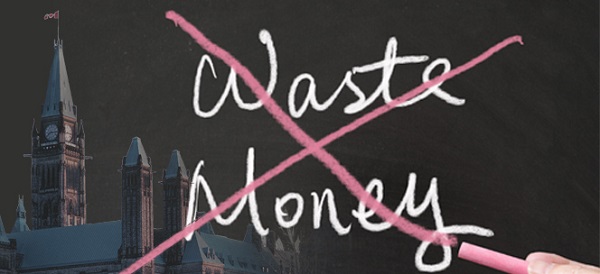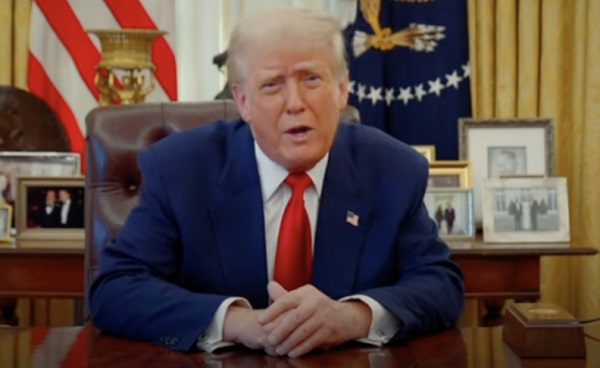Business
Canada’s department of government efficiency: A blueprint

From the Canadian Taxpayers Federation
Average compensation for a federal bureaucrat is $125,300. Cutting back the bureaucracy to population growth would save taxpayers $9 billion every year
Dumb government spending doesn’t stop at the 49th parallel.
U.S. President-elect Donald Trump announced the creation of a Department of Government Efficiency, with a mandate to “dismantle government bureaucracy, slash excess regulations, cut wasteful expenditures, and restructure federal agencies.”
Those marching orders sure would sound good in a prime minister’s mandate letter to a finance minister. And here’s the blueprint they should follow.
Begin with crazy research Canadian taxpayers are forced to subsidize.
The Social Sciences and Humanities Research Council spends $1 billion a year supporting “research and research training in the social sciences and humanities.”
Here’s a little taste of the reports it funds with your tax dollars:
- Gender Politics in Peruvian Rock Music ($20,000)
- Cart-ography: tracking the birth, life and death of an urban grocery cart, from work product to work tool ($105,000)
- My Paw in Yours: Dead Pets and Transcendence of Species Divides in Experimental Art-Making Practice ($17,500)
- Playing for Pleasure: The Affective Experience of Sexual and Erotic Video Games ($50,000)
And that’s just the tip of the iceberg.
Parks Canada put Mr. Magoo in charge of its hunting operations. It spent four years and $10,000 capturing a single bullfrog and dropped $800,000 hunting 84 deer on a B.C. Island. How can a simple hunt cost $10,000 per deer?
Well, hunting gets more expensive when instead of your grandpa’s old rifle, you use prohibited semi-automatic weapons, instead of a box of shells, you get a crate of ammo, and instead of your buddy’s old pickup, you rent a helicopter for $67,000.
Or how about the $8-million barn at Rideau Hall. Or $12,500 live senior citizen sex story shows. Or the $8,800 sex toy show in Germany. Or the millions wasted producing government podcasts no one listens to.
Then there’s government officials living high on the hog.
Governor General Mary Simon spent $71,000 on limo services in Iceland. Bureaucrats spend $76,000 a month renting art. Global Affairs Canada spends $51,000 on booze a month.
Now, the big stuff.
The size and cost of the government is out of control. Prime Minister Justin Trudeau hired 108,000 new bureaucrats. That’s a 42 per cent increase in less than a decade.
Had the bureaucracy only increased with population growth, there would be 72,491 fewer bureaucrats today.
Average compensation for a federal bureaucrat is $125,300. Cutting back the bureaucracy to population growth would save taxpayers $9 billion every year.
It’s time to stop rewarding failure with bonuses.
The feds dished out $1.5 billion in bonuses since 2015.
And the bonuses flow despite federal departments only managing to hit half of their performance targets once in the past five years.
Government executives overseeing ArriveSCAM took $340,000 in bonuses.
The Canada Mortgage and Housing Corporation rubberstamped $102 million in bonuses amid the worst housing crisis in Canadian history.
The Bank of Canada printed $20 million in bonus cheques in 2022, as inflation reached a 40-year high.
The CBC dished out $132 million in bonuses since 2015.
The next thing on the chopping block? Corporate welfare.
Trudeau put taxpayers on the hook for $30 billion in subsidies to multinational corporations like Honda,Volkswagen, Stellantis and Northvolt.
Federal corporate subsidies totalled $11.2 billion in 2022 alone.
Shutting down the federal government’s seven regional development agencies would save taxpayers an estimated $1.5 billion annually.
True efficiency would also mean eliminating failing government operations altogether. The feds should sell any Crown corporation that can, or should, be left to the private sector.
Here are a few examples.
The CBC, which takes more than $1 billion from taxpayers annually.
Canada Post, which lost $1.2 billion in the last two years and forecasts “larger, unsustainable losses in future years.”
VIA Rail, took $1.8 billion in taxpayer cash during the past five years just to cover operating losses.
The bad news for taxpayers is we pay too much tax because the government wastes too money. The list of wasteful spending in this article is far from exhaustive.
Other examples include the multi-billion dollar gun confiscation that police officers say won’t work, the $25-billion equalization scheme and taxpayer-funded media bailouts, among others.
The good news is a champion of taxpayers could make massive cuts and barely anyone outside the Ottawa bubble would notice.
This is the blueprint to slash Ottawa’s wasteful, bloated bureaucracy. All we need now is a prime minister with the guts to pick up the scissors.
Alberta
Big win for Alberta and Canada: Statement from Premier Smith

Premier Danielle Smith issued the following statement on the April 2, 2025 U.S. tariff announcement:
“Today was an important win for Canada and Alberta, as it appears the United States has decided to uphold the majority of the free trade agreement (CUSMA) between our two nations. It also appears this will continue to be the case until after the Canadian federal election has concluded and the newly elected Canadian government is able to renegotiate CUSMA with the U.S. administration.
“This is precisely what I have been advocating for from the U.S. administration for months.
“It means that the majority of goods sold into the United States from Canada will have no tariffs applied to them, including zero per cent tariffs on energy, minerals, agricultural products, uranium, seafood, potash and host of other Canadian goods.
“There is still work to be done, of course. Unfortunately, tariffs previously announced by the United States on Canadian automobiles, steel and aluminum have not been removed. The efforts of premiers and the federal government should therefore shift towards removing or significantly reducing these remaining tariffs as we go forward and ensuring affected workers across Canada are generously supported until the situation is resolved.
“I again call on all involved in our national advocacy efforts to focus on diplomacy and persuasion while avoiding unnecessary escalation. Clearly, this strategy has been the most effective to this point.
“As it appears the worst of this tariff dispute is behind us (though there is still work to be done), it is my sincere hope that we, as Canadians, can abandon the disastrous policies that have made Canada vulnerable to and overly dependent on the United States, fast-track national resource corridors, get out of the way of provincial resource development and turn our country into an independent economic juggernaut and energy superpower.”
Business
Canada may escape the worst as Trump declares America’s economic independence with Liberation Day tariffs

 MxM News
MxM News
Quick Hit:
On Wednesday, President Trump declared a national emergency to implement a sweeping 10% baseline tariff on all imported goods, calling it a “Declaration of Economic Independence.” Trump said the tariffs would revitalize the domestic economy, declaring that, “April 2, 2025, will forever be remembered as the day American industry was reborn.”
Key Details:
-
The baseline 10% tariff will take effect Saturday, while targeted “reciprocal” tariffs—20% on the EU, 24% on Japan, and 17% on Israel—begin April 9th. Trump also imposed 25% tariffs on most Canadian and Mexican goods, as well as on all foreign-made cars and auto parts, effective early Thursday.
-
Trump justified the policy by citing foreign trade restrictions and long-standing deficits. He pointed to policies in Australia, the EU, Japan, and South Korea as examples of protectionist barriers that unfairly harm American workers and industries.
-
The White House estimates the 10% tariff could generate $200 billion in revenue over the next decade. Officials say the added funds would help reduce the federal deficit while giving the U.S. stronger leverage in negotiations with countries running large trade surpluses.
Diving Deeper:
President Trump on Wednesday unveiled a broad new tariff policy affecting every imported product into the United States, marking what he described as the beginning of a new economic era. Declaring a national emergency from the White House Rose Garden, the president announced a new 10% baseline tariff on all imports, alongside steeper country-specific tariffs targeting longstanding trade imbalances.
“This is our Declaration of Economic Independence,” Trump said. “Factories will come roaring back into our country — and you see it happening already.”
The tariffs, which take effect Saturday, represent a substantial increase from the pre-Trump average U.S. tariff rate and are part of what the administration is calling “Liberation Day” for American industry. Reciprocal tariffs kick in April 9th, with the administration detailing specific rates—20% for the European Union, 24% for Japan, and 17% for Israel—based on calculations tied to bilateral trade deficits.
“From 1789 to 1913, we were a tariff-backed nation,” Trump said. “The United States was proportionately the wealthiest it has ever been.” He criticized the establishment of the income tax in 1913 and blamed the 1929 economic collapse on a departure from tariff-based policies.
To underscore the move’s long-anticipated nature, Trump noted he had been warning about unfair trade for decades. “If you look at my old speeches, where I was young and very handsome… I’d be talking about how we were being ripped off by these countries,” he quipped.
The president also used the moment to renew his push for broader economic reforms, urging Congress to eliminate federal taxes on tips, overtime pay, and Social Security benefits. He also proposed allowing Americans to write off interest on domestic auto loans.
Critics of the plan warned it could raise prices for consumers, noting inflation has already risen 22% under the Biden administration. However, Trump pointed to low inflation during his first term—when he imposed more targeted tariffs—as proof his strategy can work without sparking runaway costs.
White House officials reportedly described the new baseline rate as a guardrail against countries attempting to game the system. One official explained the methodology behind the reciprocal tariffs: “The trade deficit that we have with any given country is the sum of all trade practices, the sum of all cheating,” adding that the tariffs are “half of what they could be” because “the president is lenient and he wants to be kind to the world.”
In addition to Wednesday’s sweeping changes, Trump’s administration recently imposed a 25% tariff on Chinese goods tied to fentanyl smuggling and another 25% on steel and aluminum imports—revoking previous carve-outs for countries like Brazil and South Korea. Future tariffs on semiconductors, pharmaceuticals, and raw materials such as copper and lumber are reportedly under consideration.
Trump closed his remarks with a message to foreign leaders: “To all of the foreign presidents, prime ministers, kings, queens, ambassadors… I say, ‘Terminate your own tariffs, drop your barriers.’” He declared April 2nd “the day America’s destiny was reclaimed” and promised, “This will indeed be the golden age of America.”
-

 2025 Federal Election1 day ago
2025 Federal Election1 day agoMark Carney refuses to clarify 2022 remarks accusing the Freedom Convoy of ‘sedition’
-

 2025 Federal Election2 days ago
2025 Federal Election2 days agoLiberal MP Paul Chiang Resigns Without Naming the Real Threat—The CCP
-

 2025 Federal Election2 days ago
2025 Federal Election2 days agoPM Carney’s Candidate Paul Chiang Steps Down After RCMP Confirms Probe Into “Bounty” Comments
-

 Business1 day ago
Business1 day agoSaskatchewan becomes first Canadian province to fully eliminate carbon tax
-

 Business2 days ago
Business2 days agoTrump says ‘nicer,’ ‘kinder’ tariffs will generate federal revenue
-

 2025 Federal Election2 days ago
2025 Federal Election2 days agoFight against carbon taxes not over yet
-

 Automotive1 day ago
Automotive1 day agoElectric cars just another poor climate policy
-

 International1 day ago
International1 day agoTrump’s ‘Golden Dome’ defense shield must be built now, Lt. Gen. warns





